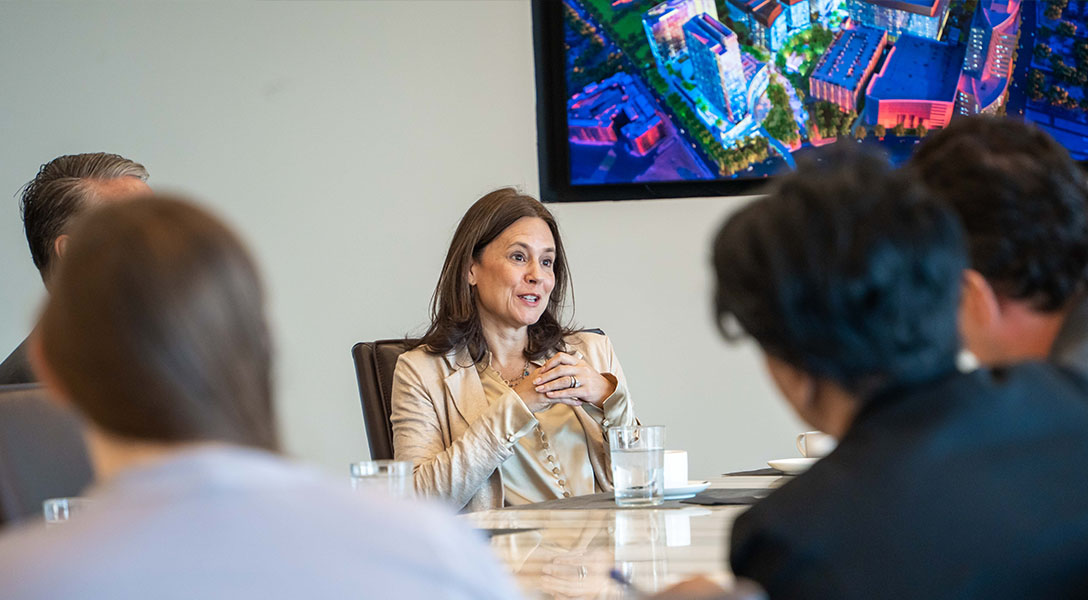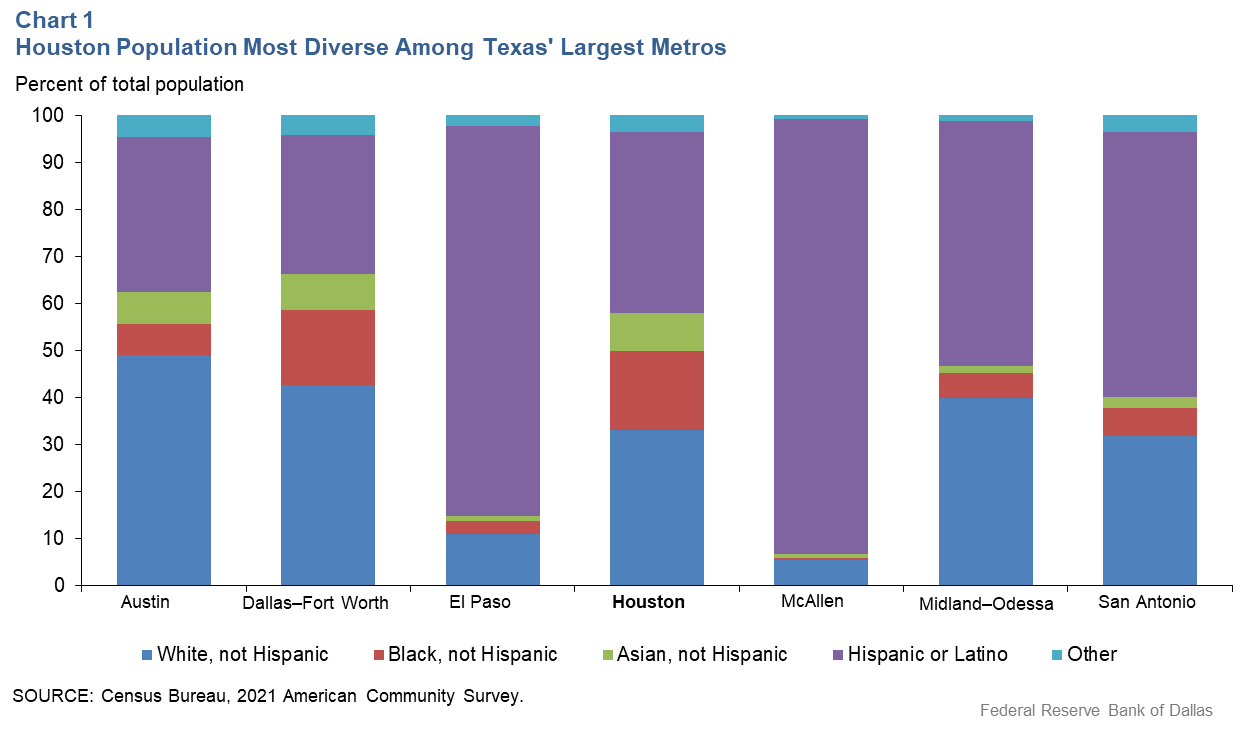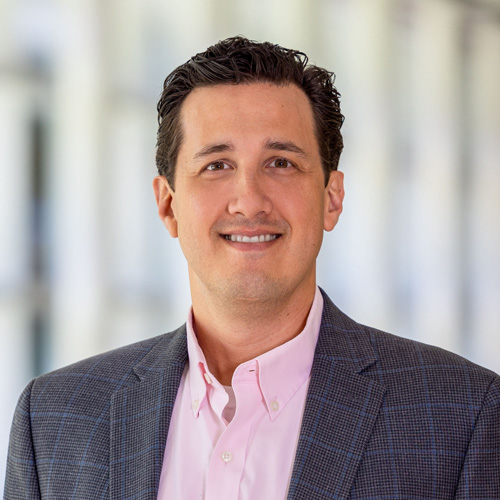
Diverse, resilient Houston looking at moving beyond traditional energy base
| 360° in 365 Houston Takeaways |
|
|
Dallas Fed President Lorie K. Logan met with Houston business and community leaders earlier this month to learn about the area’s strengths, challenges and outlook. Houston was the first stop in the 360° in 365 Listening Tour as Logan travels through the Eleventh District reaching out to local constituents so she can best represent the district in the national policy discussion and be a force for good at home. Over the course of the coming year, this listening and learning experience will position her and the Dallas Fed to identify policy priorities that will make the greatest impact for the region over the long term. We describe the Houston region and share what was discussed. |
Houston is the nation’s fifth-most-populous metropolitan area and a global energy capital. While its economy was late to recover from the pandemic, it’s the fastest-growing major metropolitan area in Texas this year. It boasts the third-busiest U.S. seaport and is a global hub of petrochemical and refining operations. Houston is also Texas’ most diverse city; no one racial or ethnic group is a majority, and nearly 1 in 4 Houstonians is an immigrant.
 During Logan’s recent visit, two of Houston’s long-run priorities came into focus. The first is the need for economic diversification. The energy transition from fossil fuels to renewables has tremendous implications for the future of Houston’s economy. Local leaders agreed the solution is to diversify, building a broader economic base that includes other growth industries.
During Logan’s recent visit, two of Houston’s long-run priorities came into focus. The first is the need for economic diversification. The energy transition from fossil fuels to renewables has tremendous implications for the future of Houston’s economy. Local leaders agreed the solution is to diversify, building a broader economic base that includes other growth industries.
A second priority is integrating immigrants and creating opportunities for Houston’s underserved communities more broadly; leaders in the region said schools, local government, nonprofits and for-profits must seek to work together to this end.
Expanding energy dominance beyond fossil fuels
The energy industry remains a dominant feature of Houston’s economy. Oil and gas and related industries directly accounted for about 11 percent of Houston jobs over the past decade, versus about 3 percent in the U.S. as a whole. Energy company headquarters are clustered in Houston, home to many of the nation’s largest public and private oil companies.
The transition from fossil fuels weighs on the long-term growth prospects of the oil and gas sector. The recent past has been tumultuous, with nature and geopolitics playing roles—a historic freeze that broke the state’s power grid in February 2021, record heat waves and, most recently, Russia’s war against Ukraine and the resulting energy crisis in Europe.
Taken together, industry leaders saw these events as highlighting the need for diverse energy sources, better energy storage technology and sufficient supply to meet demand so that energy markets can avoid disruption and price volatility.
Leading the energy transition
Local leaders told Logan they are optimistic that Houston can become a global leader in the energy transition.
Industry leaders believe the region’s relatively high concentration of engineering talent, a solid base of support services for complex, large-scale offshore and onshore drilling projects, and legacy oil and gas infrastructure can be leveraged to assist in the energy transition and decarbonization. Notable in the effort are technologies such as carbon capture and sequestration, sustainable fuels, advanced recycling and innovations in hydrogen.
A limited pipeline of skilled labor entering the energy and related sectors is a pressing concern among industry leaders, who cited the effects of climate advocates’ push to reduce fossil fuel use as well as the traditional energy sector’s reputation as a primary contributor to climate change. Industry leaders said these perceptions particularly discourage young workers who sometimes question the viability—and ethics—of pursuing a career in traditional energy.
Similarly, although investment returns are the primary driver of access to capital, industry executives see some investors’ climate concerns as an additional impediment to funding fossil fuel projects. Given the decades that will likely be required to complete the energy transition, industry executives viewed these forces as restricting traditional energy and oil and gas production growth and creating inflationary pressure.
Broadening economic inclusion to grow the economy
People from all over the world have made Houston their home. Among Texas’ major metropolitan areas, Houston is the most diverse (Chart 1). Logan heard that integrating immigrants into the economy and providing more opportunities to Houston’s low-income population are key economic development priorities. The need to improve the quality of public schools was a concern frequently mentioned.

On a visit to Houston-based BakerRipley, Texas’ largest charitable organization, Logan learned that the organization serves more than 500,000 people annually in a community-based setting. It operates more than 70 sites, offering a range of programs and services, including workforce training, education, health and wellness, and legal assistance.
Workforce development seeks to enhance access to the job market through vocational training, English-as-a-second-language classes and social mobility mentoring for adults. GED programs for at-risk youth, many of them children of immigrants, provide a gateway to further education and enhanced employment opportunities.
Leaders from nonprofits and businesses identified education as a top priority. In addition to providing a safe and healthy learning environment, these leaders work to incorporate business content in school programs to prepare students for future employment, address language barriers, and attract and retain talented teachers.
During the pandemic, BakerRipley saw an increase in the need for certain outreach services. For example, they assisted a record number of individuals with tax filings due to the expanded child tax credit and other federal emergency assistance programs. In recent months, new signs of stress have emerged with an increase in requests for rent, mortgage and utility assistance. More middle-class households have begun seeking aid, BakerRipley officials said.
Expanding the Texas Medical Center’s impact
The Texas Medical Center is a key element in Houston’s quest to diversify its economy. Regarded as the world’s largest medical complex, the TMC Medical Campus employs more than 100,000 people on its 50-million-square-foot campus in the center of the city. Health care services make up more than 8 percent of local jobs.
The $3 billion TMC Helix Park is a focal point for medical research in the region, particularly biotech and bioengineering. The mixed-use research, residential and commercial campus is under construction as part of the medical center. Leaders have also boosted backing for a business start-up accelerator, promoting development of advanced medical technology and its commercialization and manufacturing.
Thanks to support from both nonprofit and corporate partners, the TMC Innovation Factory has drawn interest from investors while nurturing entrepreneurship. A 500-acre biomedical manufacturing park, TMC Bioport, being built next to research facilities supports the transition of new technologies from the laboratory to production.
Prominent at the incubator are advanced robotics in the lab, artificial intelligence and innovations in telemedicine that enable remote medical consultations in business settings, schools and underserved communities in rural and hard-to-reach locations.
On a day-to-day basis, a worsening nurse shortage is increasing the medical center’s labor costs. In addition, the TMC Helix Park development is constrained by the same factors affecting commercial construction elsewhere: rising material costs, supply-chain delays and labor shortages.
Overall, higher interest rates and a diminished risk appetite among investors and lenders are limiting access to capital and forcing a reduction in the scale of some medical center plans, including new hospitals.
Tradition of private-public partnership cause for optimistic outlook
In her meetings with business and community leaders, Logan learned that the Houston economy wrestles with many of the same problems as the state and nation—high inflation, a tight labor market, supply-chain disruptions and rising interest rates. But some of the more-enduring challenges are unique to Houston, including a need for industry diversification and greater integration of immigrant and vulnerable populations into all segments of the economy.
Local leaders expressed optimism about the future of the region. They cited public-private partnerships—government, nonprofit and for-profit entities working together—as an instrument of change, enhancing the region’s strengths to improve its resilience and prosperity. Such partnerships have played a key role in helping the region work through multiple crises, most notably Hurricane Harvey in 2017.
About the Authors
Eleventh District 360° in 365 Tour: The Houston Visit
Oct. 4
- Reception, dinner and roundtable discussion with Dallas Fed and Houston Branch board members and Federal Advisory Council members at the Houston Branch.
Oct. 5
- Tour of Texas Medical Center Innovation Factory and meeting with Texas Medical Center executives.
- Site visit to BakerRipley community center site and roundtable discussion with community development leaders from BakerRipley, United Way of Greater Houston, Urban League, Greater Houston Partnership, Local Initiatives Support Corp. and Catholic Charities.
- Luncheon and roundtable discussion with business and community leaders from Houston Endowment, Camden Properties, Houston Port Authority, Houston Hispanic Chamber of Commerce, Greater Houston Women’s Chamber of Commerce, National Bank & Trust, Transwestern, Cadence Bank, Westlake Chemical Corp. and Harris Health System.
The views expressed are those of the authors and should not be attributed to the Federal Reserve Bank of Dallas or the Federal Reserve System.





